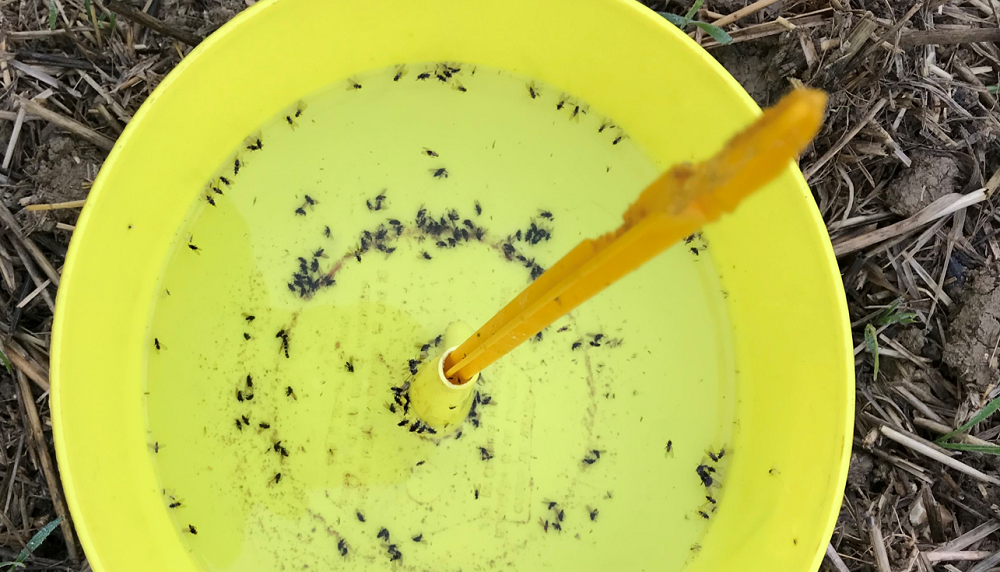The ‘Acrobat’ that juggles pyrethroids in cereals
Thursday, 7 December 2023
With chemical control of cereal aphids in the autumn limited to foliar applications of pyrethroid insecticides, judging when to spray can be a juggling act. However, a decision support system (DSS) – called Acrobat – could help farmers manage aphid virus (BYDV) risks in wheat and barley.
Transmitted primarily by the bird cherry-oat aphid and grain aphid, Barley yellow dwarf virus (BYDV) is a major disease of UK wheat and barley.
Careful use of pyrethroid insecticides in the autumn is often required to kill aphids, especially in high-risk situations. However, grain aphids with moderate levels of pyrethroid resistance are present in the UK.
Additionally, with increasing pressure to reduce (even eliminate) pesticide usage in general, farmers need reliable risk-based guidance to inform management, including the better targeting of sprays.
In autumn 2019, an AHDB-funded study got underway to improve integrated pest management (IPM) approaches for aphid control and BYDV risk management.
Specially, the ADAS-led project focused on improved monitoring of BYDV risk and the development of the next generation of decision support systems.
The final report is now available on the AHDB website. This article provides an overview of the key findings.
Improved monitoring
The project exploited data from a UK network of suction traps and examined in-field monitoring methods.
Funded by the Biotechnology and Biological Sciences Research Council (BBSRC), aphid catches from the 12.2m suction traps are processed daily during the ‘aphid season’, with the species identified and counted by the Rothamsted Insect Survey (RIS). It is a strategically important resource. For example, it provides a long-term record of the duration and intensity of the aphid-migration period on a regional basis.
This project assessed the relevance of suction trap data to commercial crops.
To monitor aphids in crops, the team used plant inspections, yellow water traps and yellow sticky traps.
Bird-cherry oat aphids were far more common than grain aphids (in all regions). For the former aphid, yellow water traps were the most effective monitoring method, whereas plant inspections were the most effective method (potentially the only effective method) of monitoring grain aphids.
At the start of the project, each suction trap was considered broadly representative of aphid flight activity over a radius of about 80 km. However, the crop monitoring data showed that bird cherry-oat aphid numbers from suction traps could only reliably gauge crop infestation within 10–20 km of the suction trap (before any insecticide spray). The result means that in-field monitoring is more important than initially believed.
The work also identified the need for advisers and growers to improve their ability to monitor and identify aphids accurately.
Interestingly, the work found that suction trap data on the percentage of aphids carrying the virus was reliable over a greater area than previously thought, with accuracy good up to 40 km away.
Concerningly, the percentage of aphids carrying the virus was higher than in previous surveys, especially the RPV variant (which has implications for varietal tolerance and resistance).
Decision support systems
The current AHDB BYDV management tool for cereals is a relatively simple (and effective) decision support system. It estimates when the second aphid generation (most associated with BYDV spread) is likely to be present, based on accumulated daily air temperatures – the temperature sum starts at crop emergence or after a spray.
The researchers examined the potential to better predict aphid population dynamics by increasing the input parameters considered by a DSS (which they named ‘Acrobat’*), including:
- Aphid pressure data: such as from suction traps (including the percentage of viruliferous aphids) and in-field observations
- Enhanced temperature data: such as minimum, maximum and mean temperatures
- Additional crop data: such as cereal type (wheat or barley), BYDV tolerance status, sowing date, plant populations, treatment costs, predicted yield, estimated grain price and local risk factors
In surveys of untreated crops, Acrobat accurately predicted BYDV risk (based on symptom development). As the DSS can indicate potential risk, it can inform pre-sowing decisions (such as crop choice and drilling date).
In tramline and plot trials, Acrobat-guided sprays provided consistent BYDV control, as good as or better than the current BYDV management tool. The better news is that it did this with fewer insecticide applications and provided yield benefits (where BYDV was present).
With proof of concept established, Acrobat requires development work to produce a web-based or app-based version for industry.
Access the final report
‘Management of aphid and BYDV risk in winter cereals’ is the final project report of a three-year project (21120077a) that started in August 2019. The work cost £314,500 (cash and in kind), including a £190,000 cash contribution from AHDB.
Access the final project report
Watch an update
On 7 December 2023, Sacha White (ADAS), lead researcher for the project, provided an overview of the BYDV work at the AHDB Agronomy Conference.
He presented several fascinating charts. One showed the large impact of sowing date and another illustrated how the proportion of aphids with the virus influences crop risk. Maps also showed how the UK area reliably covered by aphid suction trap data has shrunk (based on the project's findings).
The presentation also provided an AHDB research update on:
- Informing the next generation of insecticide resistance management guidance
- Reducing the impact of cabbage stem flea beetle on oilseed rape
 ADAS
ADAS
Topics:
Sectors:
Tags:


